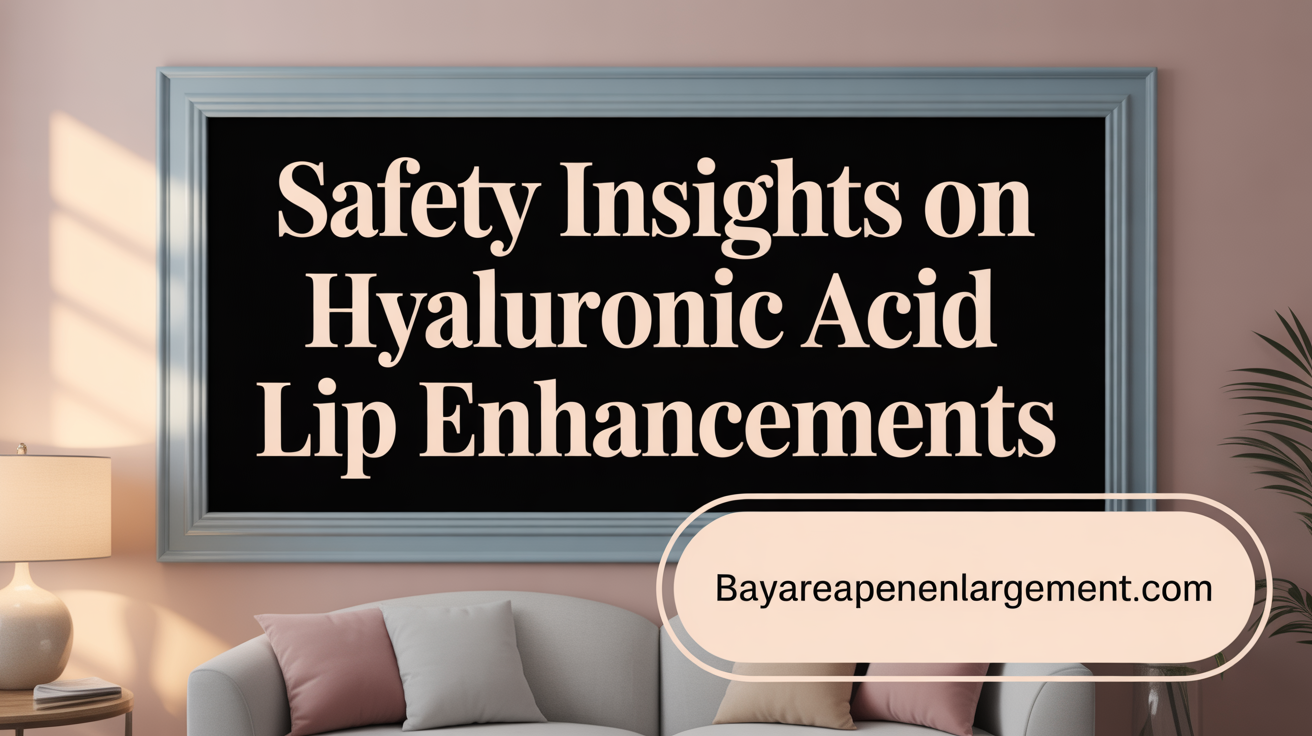Introduction to HA Fillers and Their Growing Popularity
Hyaluronic acid (HA) dermal fillers have surged in popularity as non-surgical solutions to aging and aesthetic concerns, offering immediate results with minimal downtime. As naturally occurring substances within the skin, HA fillers are designed to restore volume, smooth wrinkles, and enhance facial contours. Despite their widespread use and general safety, understanding the risks, potential side effects, and best practices before undergoing treatment is essential for both patients and healthcare providers. This article delves into the safety profile of HA fillers, highlights possible complications, and emphasizes critical safety protocols to ensure patient well-being.
What Are Hyaluronic Acid Fillers and How Do They Work?
Definition of HA fillers
Hyaluronic acid (HA) fillers are soft gel-like substances used in cosmetic treatments to restore facial volume, smooth lines, and improve skin hydration. They are among the most popular dermal fillers because of their effectiveness and safety profile.
Nature of hyaluronic acid in the body
Hyaluronic acid is a naturally occurring substance in the human body. It is found in the skin, joints, and connective tissues, where it plays a vital role in retaining water, helping skin stay plump and elastic. Its natural presence in the body makes HA fillers highly compatible and safe.
Mechanism of action
HA fillers work by injecting the gel into specific areas of the face, where they add volume and support to the skin. This action reduces the appearance of fine lines and wrinkles, enhances facial contours, and provides a hydrated, youthful look. Additionally, HA stimulates collagen production, which can further improve skin quality over time.
Common treatment areas
These fillers are used in various parts of the face, including the lips, cheeks, nasolabial folds, chin, under-eye hollows, and jawline. They are also applied to restore volume in the hands. The versatility of HA fillers allows for personalized treatments tailored to individual aesthetic goals.
Duration and reversibility of effects
The effects of hyaluronic acid fillers typically last between six months to a year, depending on the type of product used, the treatment site, and individual metabolism. If necessary, HA fillers can be quickly dissolved with an enzyme called hyaluronidase, making them reversible and a flexible choice for patients.
Hyaluronic acid fillers offer a safe, effective way to rejuvenate facial appearance, with the added benefit of reversibility and natural integration with the body's tissues.
Safety Profile of Hyaluronic Acid Lip Fillers

Are hyaluronic acid lip fillers safe?
Hyaluronic acid (HA) lip fillers are widely regarded as a safe choice for lip enhancement when administered by a qualified and experienced healthcare professional. Because hyaluronic acid is a natural component of the skin and connective tissue, these fillers are well-tolerated and unlikely to cause severe allergic reactions.
The procedure involves injecting a gel-like substance into specific parts of the lips to improve volume, shape, and symmetry or to smooth out wrinkles. Most patients experience only mild and temporary side effects such as swelling, bruising, and temporary sensitivity, which typically resolve within a few days.
However, like any medical procedure, lip filler injections carry some risks. Potential adverse events include bleeding, infection, allergic reactions, tissue death (necrosis), or filler migration. These complications are rare when the procedure is performed by a skilled provider using proper techniques and sterile equipment.
The importance of choosing a trained, licensed healthcare professional cannot be overstated. Proper assessment, precise injection techniques, and appropriate patient management significantly reduce the likelihood of adverse effects.
Fortunately, hyaluronic acid fillers are dissolvable with an enzyme called hyaluronidase, which can quickly reverse unintended results or manage complications if necessary. This reversibility makes HA lip fillers a flexible and generally safe option for most patients seeking lip enhancement.
In summary, with proper technique and professional care, hyaluronic acid lip fillers are a safe, effective, and reversible option for enhancing the lips, contributing to natural-looking results and patient satisfaction.
Common Risks and Side Effects Associated with Hyaluronic Acid Fillers

What are the common risks and side effects of hyaluronic acid fillers?
Hyaluronic acid (HA) fillers are widely used for facial rejuvenation due to their safety profile and effectiveness. Most adverse events, over 90%, are mild and resolve on their own within a few days. These include redness, swelling, bruising, tenderness, and temporary discomfort at the injection site.
Hematoma and bruising
Bruising and hematomas are frequent immediately after injection and can last from a few days to a week. Proper injection techniques, such as gentle handling and selecting appropriate sites, help reduce these risks. Applying ice immediately after the procedure can also minimize swelling and bruising.
Nodules and Tyndall effect
Nodules or bumps may develop due to incorrect placement or immune reaction. The Tyndall effect, a bluish discoloration, can occur if the filler is too superficially injected. Both issues can often be treated effectively with hyaluronidase, which dissolves hyaluronic acid. Proper technique and product placement are vital to prevent these problems.
Allergic reactions and infections
Though rare, allergic reactions may present as itching, rash, or swelling. Infections at the injection site, caused by non-sterile technique or contaminated equipment, can lead to inflammation, pus, or abscesses. Maintaining strict sterile procedures reduces infection risk.
Rare severe complications including vascular occlusion
One of the most serious risks involves accidental injection into a blood vessel, which can block blood flow, leading to tissue necrosis, skin ulceration, or even vision loss, including blindness. Immediate recognition and treatment with hyaluronidase can help dissolve the filler and restore blood flow. Knowledge of facial vascular anatomy and careful technique are essential to prevent this.
Management of side effects
Most common side effects are transient and manageable. They can be alleviated with topical steroids, antihistamines, or hyaluronidase. Early detection of vascular occlusion may require high-dose hyaluronidase injections, and in cases of skin necrosis, prompt wound care is necessary.
In conclusion, while hyaluronic acid fillers are generally safe, understanding potential risks, practicing meticulous injection techniques, and being prepared to manage complications are vital for patient safety and satisfaction. Consulting with experienced healthcare professionals and ensuring treatments are performed in sterile environments significantly minimizes risks.
Why Caution Is Advised When Using Hyaluronic Acid Fillers
Why might some plastic surgeons advise caution with hyaluronic acid fillers?
Hyaluronic acid (HA) fillers are among the most popular and generally safe options for facial rejuvenation. However, experienced practitioners stress the importance of caution during administration. Improper injection techniques, such as injecting too superficially or using excessive volume, can increase the risk of side effects. Over-injection can lead to swelling, noticeable asymmetry, or uneven contours, which can sometimes be challenging to correct even after treatment.
One notable concern is granuloma formation. These are small nodules that develop as a body’s immune response reacts to the filler, sometimes appearing months or years after the initial injection. Though rare, granulomas can cause persistent firmness and aesthetic issues, often requiring medical or surgical intervention.
Vascular complications, such as tissue necrosis and even blindness, are among the most serious risks although they are infrequent. These can occur if the filler unintentionally enters or compresses a blood vessel during injection. Proper knowledge of facial anatomy and the use of precise techniques are essential to minimize this danger.
Patient-specific factors also influence risk levels. Allergies, sensitivities, or underlying health conditions can heighten the chance of adverse reactions. An individualized and thorough patient assessment before treatment helps identify potential issues and manage expectations.
In summary, although hyaluronic acid fillers are considered safe, their proper use depends on highly skilled administration. Careful injection methods, awareness of facial vascular anatomy, and detailed patient evaluation are crucial to ensuring safe outcomes and avoiding serious complications.
Long-Term Safety Considerations and Outcomes of Dermal Fillers
What are the long-term safety considerations and outcomes of dermal fillers?
Dermal fillers generally provide safe, effective facial rejuvenation when administered properly by qualified professionals. However, understanding their long-term safety profile is crucial for both practitioners and patients.
One of the main concerns is the potential for chronic or delayed adverse reactions. These can include persistent swelling, small lumps, or nodules that may last for months or even become permanent if not properly treated. Granulomas, which are small inflammatory nodules, can develop as a reaction to the filler material, contamination, or immune responses. Such granulomas are more common with certain fillers, such as permanent or semi-permanent options, but can also occur with hyaluronic acid-based products.
Histological studies of tissue response reveal that some fillers induce foreign body reactions, characterized by the presence of immune cells like macrophages and lymphocytes. These tissue responses sometimes lead to fibrosis or granuloma formation, especially if immune system hypersensitivities or contamination occur during injection.
While serious late-onset complications are rare, they include the development of persistent lumps, swelling, or granulomas that require medical intervention. Proper injection techniques, sterile procedures, and careful patient selection are essential to minimize these risks.
Monitoring patients over time is critical. Patients should be educated on what to expect post-treatment and instructed to report any unusual or persistent issues promptly. Early detection of adverse effects allows for timely management, which may involve treatments like corticosteroids, hyaluronidase (for HA fillers), or surgical removal.
In summary, long-term outcomes of dermal fillers are generally positive, with most issues resolving spontaneously or responding well to treatment. However, rare but significant complications can occur months or years after the initial procedure, emphasizing the importance of ongoing patient follow-up and education to ensure safety and satisfaction.
Understanding and Managing Severe Complications

Vascular occlusion risks and prevention
A major concern with dermal filler injections is accidental occlusion of blood vessels, which can lead to tissue necrosis or even blindness. To minimize this risk, practitioners must have a thorough understanding of facial vascular anatomy. Techniques such as slow, low-pressure injections, using blunt cannulas instead of needles, and avoiding high-risk areas reduce the likelihood of intravascular injection.
Recognizing signs of blanching and severe pain
Early signs of vascular compromise include skin blanching—where the skin appears pale or white—and intense, persistent pain that does not resolve. Immediate recognition of these symptoms is crucial, as they indicate potential vascular occlusion requiring urgent intervention.
Use of hyaluronidase in emergency treatment
Hyaluronidase is an enzyme that can rapidly dissolve hyaluronic acid-based fillers. In case of suspected vascular occlusion, prompt injection of hyaluronidase can restore blood flow and mitigate tissue damage. Administering high doses as soon as symptoms are detected significantly improves outcomes.
Risks of blindness and necrosis
Vascular occlusion can cause severe damage such as skin necrosis—death of skin tissue—or loss of vision if the occlusion occurs near the eye's blood vessels. These complications are rare but require immediate medical attention to prevent permanent disability.
Importance of facial anatomy knowledge
A sound understanding of the complex network of facial blood vessels is essential. Proper injection techniques and anatomical knowledge help avoid intravascular entry and protect critical structures, especially around highly vascular areas like the glabella, nose, and eyelids.
Emergency management protocols
Protocols for managing complications involve immediate cessation of the procedure, administration of hyaluronidase, and close monitoring. Depending on the severity, additional treatments may include topical vasodilators, warm compresses, or even surgical intervention. Rapid response by trained professionals can dramatically improve patient outcomes.
Comparison with Other Dermal Fillers and Collagen Injections

What are alternative filler types and their safety profiles?
There are several types of dermal fillers used aside from hyaluronic acid (HA), each with unique characteristics. Calcium hydroxylapatite (CaHA) is a semi-permanent option known for its thicker consistency, suitable for deep wrinkles and volume restoration. Poly-L-lactic acid (PLLA) stimulates collagen production, offering a gradual and longer-lasting effect, but requiring multiple sessions. Polymethyl methacrylate (PMMA) is a permanent filler containing tiny beads suspended in a carrier substance; it offers lasting results but carries higher risks of granuloma formation and migration. Autologous fat transfer involves harvesting fat from one body part and re-injecting it into the face, which is naturally biocompatible but has more unpredictable outcomes.
What are the side effects of collagen injections?
Collagen injections can cause side effects such as skin redness, swelling, and discomfort at the injection site. Other potential reactions include bleeding, bruising, itching, or skin rashes. Infections may occur if the site is not properly sterilized, and there is a risk of scarring or lumps forming. Rarely, if the injection accidentally reaches a blood vessel, wounds or more serious complications can arise. While generally considered safe, individuals should consult with healthcare professionals to assess risks, especially if they have allergies or are taking medications.
What are the risks associated with permanent and semi-permanent fillers?
Permanent fillers like PMMA and certain fat transfer options have a higher tendency for long-term complications. These include granulomas (lumps), migration, and difficulty in reversibility if results are unsatisfactory. Semi-permanent fillers such as PLLA pose similar concerns but can be managed more effectively with proper technique and follow-up. The permanence of these substances necessitates careful consideration, as removal is often more complicated and may require surgical intervention.
What are the advantages of HA fillers’ reversibility?
Hyaluronic acid fillers are highly favored because they can easily be dissolved with an enzyme called hyaluronidase if adverse effects or unsatisfactory results occur. This reversibility provides an important safety net, allowing practitioners and patients to correct mistakes or manage complications promptly. It also enhances confidence in treatment, making HA fillers suitable for first-time users or those uncertain about the outcome.
What are the clinical considerations in filler choice?
Selecting the most appropriate filler depends on a patient’s specific needs, treatment goals, and medical history. Factors like desired longevity, safety profile, reversibility, and the area to be treated influence this decision. For example, HA fillers are preferred for their safety, ease of use, and versatility, while semi-permanent options suit those seeking longer-lasting results. A thorough assessment by qualified professionals, understanding facial anatomy, and awareness of each product’s properties are essential for optimal outcomes.
| Filler Type | Duration | Reversibility | Risks | Suitable For |
|---|---|---|---|---|
| Hyaluronic Acid | 6-18 months | Yes, via hyaluronidase | Mild, transient side effects, rare vascular issues | Lip augmentation, nasolabial folds, under-eye hollows |
| Calcium Hydroxylapatite | Up to 12 months | No | Nodule formation, migration | Deep wrinkles, contouring |
| Poly-L-lactic acid | Several months to years | No | Swelling, granulomas | Collagen building, volume restoration |
| Polymethyl methacrylate | Permanent | No | Granulomas, migration | Deep scars, volume loss |
Ensuring Safety: Role of Qualified Healthcare Providers and Best Practices
Importance of board-certified dermatologists and cosmetic surgeons
Choosing a qualified, board-certified dermatologist or cosmetic surgeon is crucial for safe dermal filler procedures. These professionals possess specialized training in facial anatomy and injection techniques, reducing the risk of complications such as vascular occlusion or tissue damage.
Proper patient evaluation and medical history review
A thorough medical history assessment helps identify potential contraindications, allergies, or previous adverse reactions. Understanding individual health conditions, medication use (e.g., blood thinners), and skin history ensures tailored, safe treatment plans.
Avoiding black-market and unapproved fillers
Only FDA-approved fillers purchased through licensed healthcare providers should be used. Black market products may contain harmful, nonsterile substances that can cause severe infections, allergic reactions, or permanent tissue damage.
Use of sterile techniques and FDA-approved products
Sterile injection techniques and sterile equipment are non-negotiable to prevent infections. Using only FDA-approved products ensures quality, safety, and predictable outcomes, minimizing risks such as nodules, granulomas, or adverse immune responses.
Continued education and training for providers
Practitioners must pursue ongoing education in the latest safety protocols, techniques, and product updates. Proper training includes understanding facial anatomy, injection methods such as cannula use, and emergency management of complications.
Patient education and informed consent
Clear communication about potential risks, side effects, and realistic results prepares patients for their treatment journey. Obtaining informed consent involves explaining possible adverse events and emphasizing the importance of choosing experienced providers for safety.
Post-Treatment Care and Patient Responsibilities for Safety

What are the common immediate post-procedure side effects?
Most patients experience mild and temporary side effects shortly after dermal filler treatments. These include redness, swelling, bruising, and tenderness at the injection sites. Discomfort is usually minimal and resolves within a few hours to days. Some individuals might notice small lumps, skin discoloration like the Tyndall effect, or slight asymmetry.
What are the recommended aftercare practices?
To promote healing and reduce side effects, patients should follow their provider's instructions carefully. Applying ice packs to the treated areas can minimize swelling and numbness. Patients are advised to avoid touching or massaging the treated zones unless instructed otherwise. It is also recommended to refrain from exposing the skin to excessive heat, sunlight, or cold, which can exacerbate swelling or irritation.
How to recognize signs of complications?
Early identification of any unusual or persistent symptoms is crucial. Symptoms such as severe pain, increasing swelling, sudden skin discoloration, or visual disturbances like blurred vision or a sudden loss of sight can indicate serious issues like vascular occlusion or skin necrosis. Immediate medical attention is essential if these signs occur.
Guidance on avoiding strenuous activities and skin trauma
Patients should avoid vigorous exercise, heavy lifting, or strenuous physical activity for at least 24-48 hours post-treatment. These activities can increase blood flow and swelling, risking complications. Additionally, patients should steer clear of facial massages, vigorous rubbing, or pressure on the treated area to prevent displacing the filler.
Why is prompt reporting of adverse events important?
Reporting any adverse reactions or unexpected symptoms to the healthcare provider helps ensure timely intervention. Prompt action can reduce the risk of permanent damage, such as tissue loss or vision problems. Patients should contact their provider immediately if they experience symptoms like sudden swelling, severe pain, skin discoloration, or vision changes.
What is the role of follow-up visits in safety?
Follow-up appointments allow the provider to monitor the treated area, manage any early complications, and assess the results. Regular check-ins help confirm proper healing and decide if touch-up treatments are necessary. These visits are vital in maintaining safety and optimizing aesthetic outcomes.
Regulatory and Scientific Oversight of HA Fillers
What is the FDA approval status of HA fillers?
Hyaluronic acid (HA) dermal fillers are approved by the U.S. Food and Drug Administration (FDA) for specific cosmetic and medical uses. They are classified as medical devices and are intended for soft tissue augmentation, such as smoothing wrinkles, adding volume to lips, and restoring facial contours. These products are approved for use in adults over the age of 22, with indications including treating moderate to severe facial wrinkles and folds, augmenting lips and cheeks, and restoring volume in the hands.
How are HA fillers regulated as medical devices?
As FDA-regulated medical devices, HA fillers undergo rigorous safety and efficacy evaluations before approval. They are classified as temporary, biodegradable, and revitalizing agents, with manufacturers required to submit extensive clinical data demonstrating their safety profile. The approval process includes detailed assessments of the product’s composition, manufacturing practices, and labeling to ensure consumer safety.
What warnings are issued against unapproved products and needle-free devices?
The FDA strongly warns against purchasing and using unapproved fillers, especially those obtained from the black market, as these may contain non-sterile or harmful substances, increasing risks of infections, allergic reactions, or skin necrosis. The agency also advises against the use of unapproved, needle-free devices for injecting fillers, citing safety concerns, including serious injuries and permanent harm. Only licensed healthcare professionals should administer FDA-approved products using sterile techniques.
Why is reporting adverse events important?
Patients and healthcare providers are encouraged to report any adverse reactions associated with HA fillers to the FDA’s MedWatch program. Reporting helps monitor safety, identify patterns of side effects, and improve the overall understanding of the products’ risk profiles. Prompt reporting is crucial for managing complications such as vascular occlusion, skin necrosis, or vision loss.
What scientific studies support the safety profile of HA fillers?
Over decades, numerous scientific studies have shown that most adverse events associated with HA fillers are mild and transient, including swelling, bruising, and redness. Research indicates that serious complications like vascular occlusion or blindness are rare—estimated at approximately 0.0001%—but require immediate intervention. The biodegradability and reversibility of HA with hyaluronidase further contribute to their safety profile.
How do HA fillers differ from neurotoxins like Botox?
While both HA fillers and botulinum toxin (Botox) are used for cosmetic facial treatments, they are distinct in their mechanisms and regulatory classifications. HA fillers restore volume and smooth wrinkles, acting as soft tissue augmenters. In contrast, Botox temporarily relaxes muscles to reduce dynamic wrinkles. Both are FDA-approved but target different signs of aging and are administered differently, emphasizing the importance of proper evaluation and professional guidance.
| Aspect | Details | Remarks |
|---|---|---|
| FDA Approval | Approved for adults 22+ | Used for wrinkles, volume, hand rejuvenation |
| Regulation | Medical devices, safety evaluated | Manufacturers must follow strict guidelines |
| Unapproved products | Warned against | Risks include infection and permanent damage |
| Adverse Event Reporting | Mandatory | Helps ensure ongoing safety monitoring |
| Scientific Evidence | Supports safety in most cases | Rare serious adverse events, reversible with hyaluronidase |
| Difference from Botox | Different mechanisms | Fillers restore volume; Botox relaxes muscles |
In conclusion, HA fillers are well-regulated, extensively studied, and safest when obtained through licensed professionals and used as approved by the FDA.
Conclusion: Balancing Benefits and Risks in HA Filler Treatments
Hyaluronic acid fillers represent a significant advancement in non-surgical aesthetic treatments, providing natural-looking results with a positive safety profile when administered by qualified professionals. While most side effects are mild and transient, understanding the spectrum of potential risks—from common injection site reactions to rare but serious vascular complications—is essential. Proper patient selection, meticulous injection technique, comprehensive education, and vigilant post-treatment care collectively ensure the best outcomes. Patients are encouraged to seek treatment exclusively from licensed healthcare providers utilizing FDA-approved products. Through knowledge, preparation, and collaboration between patient and practitioner, HA filler injections can be a safe and effective tool to enhance appearance and confidence.
References
- Dermal fillers: The good, the bad and the dangerous - Harvard Health
- Dermal Filler Do's and Don'ts for Wrinkles, Lips and More | FDA
- Adverse Events Associated with Hyaluronic Acid Filler Injection for ...
- Review of the Adverse Effects Associated with Dermal Filler ...
- Dermal Fillers (Soft Tissue Fillers) - FDA
- Ensuring Safety with Dermal Fillers and Botox - Emory Healthcare
- Hyaluronic Acid Fillers 101: Benefits and Risks Explained

